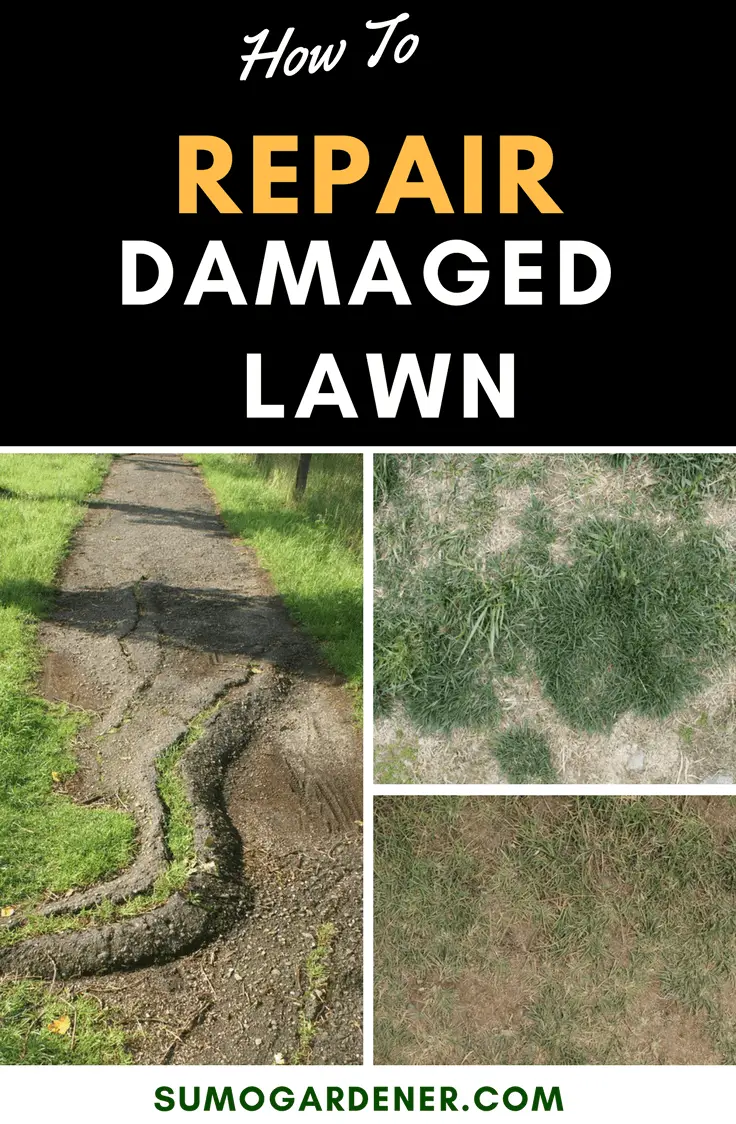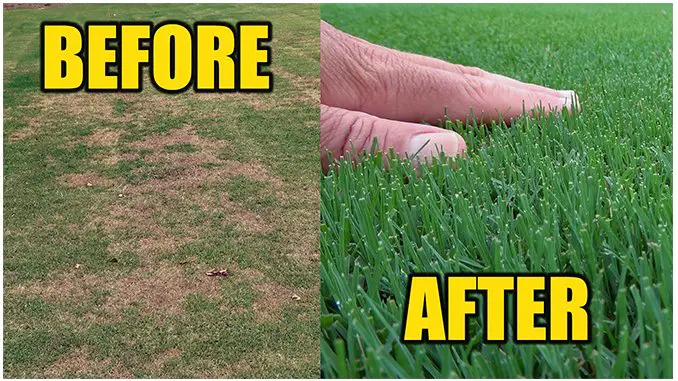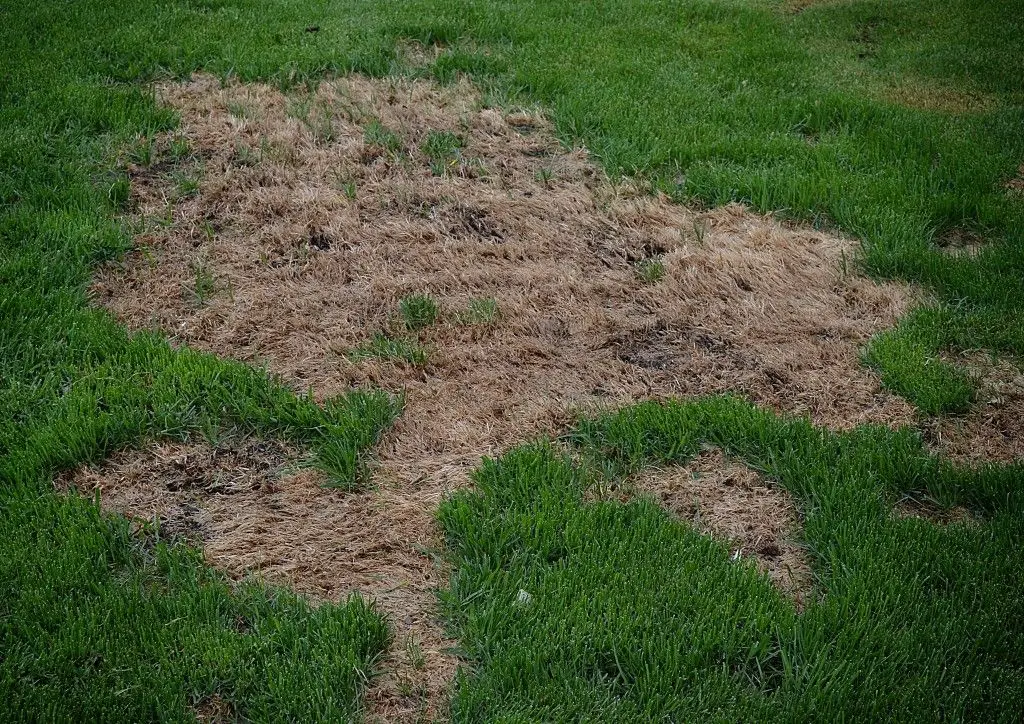Guide On How To Aerate Your Lawn
It is difficult for air, water and nutrients to penetrate into hard compacted soil and is difficult for grass to grow and flourish, so its a good idea to improve and fix areas of compacted soil. A hand-held corer or lawn aerator can be used, which removes small plugs of soil, helping to open up the soil and improve water, air and nutrient penetration down into the root zone and improved grass growth. Mechanical corers can also be used.
Applying Your Seeding Mixture
Choose a repair mixture suited to your climate, grass type and sunlight exposure. Premium grass seed, moisture-retaining mulch and stabilized-release fertilizer in Pennington One Step Complete safeguard germinating seed and nourish emerging seedlings until the lawn is ready for normal care regimens.
Smooth the seeding mixture over the soil, applying it at a rate of 1 cup per square foot. This ensures adequate sunlight for germinating and proper seed-to-soil contact for quick, thorough grass establishment. Forget about planting depth and seed stabilization simply cover exposed soil thoroughly, and water the seeding mixture well.
Proper watering is the most important and often the most neglected part of the spot repair process. Moisture-retentive mulch reduces necessary watering and keeps protected seed in place, even on slopes, but expect to water at least once daily. Let weather guide your efforts adjust your watering to keep repaired areas consistently moist, but never soggy.
Keep repaired areas evenly moist until seedlings reach the recommended mowing height for your chosen grass type. For example, a dense shade mixture should reach 2 1/2 to 3 inches tall, and tall fescue should measure 3 to 4 inches, before you reduce watering to a normal weekly or twice-weekly schedule. Seedlings emerge over seven to 21 days after repair, depending on your mix, and reach mowing height in three to four additional weeks.
When To Fix Lawn Ruts
Tire damage cant be fixed just any time of the year. Its best to wait until the grass is in a growth spurt to remove tire ruts. This is usually in the late spring or early fall, depending on the climate and the grass.
- Warm season grasses include Bermuda, Buffalo, Bahia, Saint Augustine, and Zoysia grasses. These usually have a growth spurt in the late spring.
- Cool season grasses include Kentucky Bluegrass, Fine Fescue, and Tall Fescue. Its best to wait to repair ruts until they have their growth spurt in the early fall.
Recommended Reading: Rent Aerator At Lowes
Use Your Hose For Large Areas Of Weeds
- Pour concentrated herbicide into a dial sprayer and hook it up to your garden hose.
- Turn the dial on the top of the sprayer to the setting recommended on the herbicide container .
- Spray the weeds.
- Pro tip: Spray the herbicide on a calm day so the weed killer won’t drift onto your plants and flowers.
Will Grass Spread To Bare Spots

There are three options for how a plant spreads. The first is through root spread, the second by way of seeds while their last form of spreading can be seen through offshoots.
The grass species used for lawns do not produce offshoots, so this option will not work to cover bare spots.
Some types of grass can spread through their roots without any help. However, this isnt true for all sorts and some lawns require assistance to cover bare spots!
Interesting Fact: Did you know that there are over 1,400 species of grass in the United States?
The grasses that can spread through their roots without help own stolons and rhizomes. Stolons are horizontal runners that grow slightly over the soils surface, while rhizomes grow under the soil. Both develop their own leaves and a stem, which allows grasses to spread.
Just remember you have to watch the runners because it can also cause invasive grass growth.
The second option is for grass to spread through seeds if your lawn is not mowed regularly. If its not cut the grass will grow bigger while developing flowers that produce seeds.
Those seeds can be spread through wind, animal, or water dispersal. If the conditions are suiting grass will spread to bare spots, but it might take some time.
You can speed up the process by sprinkling some grass seeds in addition. Then cover with soil and water regularly until you see green shoots appear.
Recommended Reading: How To Kill Wild Violet Weeds In Lawn
Rake Out The Dead Material
When the grass dies, for whatever reason, the dead material is left in the patch or sward of the grass to decompose slowly. To help your lawn thicken up again and recover quicker, rake out as much of this material as you can. This will provide space for the healthy grass to spread back through and also help more sunlight, water and oxygen to penetrate boosting the health of the grass in these areas.
How Long Does It Take For The Lawn To Spread
Time varies from region to region, but it usually takes about a year for the lawn to spread through seeding.
Old lawns are typically slower because they need dilution of natural vegetation. Typically, it takes about five years for a new lawn to spread about 200 feet per year. Planting grasses that are good at spreading will help you get your new lawn spread faster.
Technically, as seeds take a few weeks to germinate and grow into plants, it takes from one to three months for the lawn even to spread its first time.
Read Also: Who Sells Murray Lawn Mower Parts
How To Fix Damaged Lawn Grass
Lawns brown and die for various reasons. Grubs, animals, overfertilization, incorrect mowing and drought cause damaged and dead grass. Lawn repairs completed in spring and early fall work best because the conditions ensure that the grass seed germinates quickly. You can perform the repairs at other times, except the hottest part of the summer, but seed germination might be delayed. Treating and renovating the entire lawn improves the overall health and appearance, while preventing further damage.
1
Identify the kind of grass you currently have in the lawn. Matching the new grass seed to the current gives a more uniform appearance. With extensive lawn damage you can choose a new grass, such as a native species, that performs best in your location.
2
Measure your lawn, and multiply the length times the width to reach a total square footage. Purchase enough grass seed to cover your entire lawn following the seed rate instructions on the back of the package. Typically covering a 1000 square foot area takes between 1 and 10 pounds, but it varies based on variety.
3
Mow the lawn down to 2 inches high. Skim the damaged areas with a spade. Rake the dead grass and debris from the lawn. Discard the debris in the compost bin or trash.
4
5
6
Fill the spreader with a fertilizer formulated for starter lawns. Follow the manufacturer’s directions for the amount to use. Make one pass over the entire lawn with the fertilizer.
7
8
9
References
Warnings
Writer Bio
Weeds And Thatch: Project Shopping List
Heres what youll need to complete this project successfully.
- Weed killer chemicals
- Iron rake or thatch rake
- Walk-behind dethatching machine
Your lawn takes a beating, season to season, from winter-weather salt damage, insects, rodents and birds, family pets, weeds and thatch. While there’s not much you can do to prevent damage once it’s been done, you can make repairs to get your lawn looking lush and green again.
Although, damage to your lawn can come from any of the above stressors or all of them you can fix any unsightly or dead patches in your yard by first determining the problem, and then applying the appropriate solution. See below for step-by-step solutions to some of the most common problems that may exist in your yard.
Don’t Miss: How To Clean Lawn Mower Carburetor
Repairing Large Areas Of Lawn Damage
If you have large areas of your lawn that have been damaged by drought you can rent a machine called an over seeder. What an over seeder does slice the soil a little the drops grass seed as it moves along.
Ive used an over seeder on my lawn and it worked great, but it was a bit of a beast of a machine to use.
When I did my lawn I had a lot of weeds that came in after drought damage so I first applied weed and feed over the entire lawn to get rid of all of the weeds then I did the over seeder thing.
So you can apply weed and feed to get rid of the weeds. Then if you have thick bladed grasses that you want to get rid of you can do the spot treatment as well, before you use the over seeder.
I hope this helps. Questions?
Aerate With A Garden Fork
Aerating will help to decompact the hard-bare ground making it easier for the healthy grass to spread its roots into the bare soil. Drive a garden fork into the ground to around 100mm and wriggle it back and forth to fracture the soil profile. If you have subsoil irrigation be careful that you dont do so too deeply or where you are likely to come in contact with a pipe. After aerting can also be a good time to apply soil conditioners like gypsum to improve your soil base.
Also Check: Lawn Care Business Owner Salary
How Do You Get Grass To Spread
First, you should own a self-spreading grass species or stop mowing your lawn to get your lawn blooming and seeding itself.
Second, you can try to remove any obstacles that block sunlight. For instance, make sure no fences or bushes are shading your lawn that would prevent the sun from helping with spreading.
The right watering schedule is important! The lawn should get around one inch per week so just water three times a week for around 20 minutes and youre good to go.
Next, avoid using pesticides on your grass as this may harm it and affect how easily it spreads.
Finally, you can also help speed up germination by applying a light, grass-friendly fertilizer. But dont use it too excessively because this will harm the lawn.
Those steps will provide the younger plants with everything they need to thrive and older plants to spread faster.
Why Does My Lawn Has Damaged Spots

Grass blades should be green in color with no brown tips for healthy growth, but there are many reasons why your lawn has brown or damaged spots.
One reason for damaged patches is too much shade because grass needs enough sunlight for photosynthesis to occur. Shade from overgrown trees or even the side of your house can cause browning spots in your lawn because grass requires six hours of full sun to grow properly.
Another reason is due to a lack of water, such as during periods of drought when rainfall isnt enough for healthy growth. Grass needs approximately one inch per week so that it can absorb enough water, but damages will also develop if you over-water your lawn because grass plants will drown.
As well damaged spots can occur if the soil is not rich enough and doesnt contain enough nutrients for grass growth. Grass requires around two pounds of nitrogen supply per 1000 square feet per year and enough organic matter so it is able to thrive healthily.
If your lawn is sandy or contains too much clay the soil wont have enough nutrition for healthy growth.
Brown spots will also develop on a lawn if too many herbicides are applied to kill weeds because they contain chemicals that prevent grass from growing healthy in that spot.
Also Check: Where Are Cub Cadet Lawn Mowers Made
Preparing Bare Spots For Repair
Mow damaged spots and surrounding areas at normal spring mowing levels, and then remove dead or damaged grass to expose clean soil. If leveling is needed, add or remove topsoil, rake spots briskly, and then smooth the surface. Loose, smooth soil invites new seedlings to take hold.
Delay adding pre-emergent herbicides or weed-and-feed products to repair areas. Unless applied at least five to six weeks before seeding, these products hamper seed germination and rooting.
Give It A Little Patience
Grass doesnt grow in a day — or even in a week. Your trampled lawn might need to take a month or so to show signs of life again. Make sure that youre watering the grass seed regularly, and dont mow new growth until your lawn is between 3 and 4 inches.
In the meantime, work on establishing traffic patterns that bring life back to your outdoor space. Cultivate behaviors in your dog that will allow your efforts to take root. Pay attention to the ways that your family are using your lawn, so that you can maximize the space that you have. As your formerly trampled lawn transforms into a lush green carpet, youll be so glad you made the effort to create a space that feels good to spend time in.
*Results 28 days after application, applied and cared for according to label directions
Read Also: How To Clean Outdoor Cushions With Mold
Four: Overseeding / Reseeding
We recommend waiting two weeks for the fertiliser to take full effect before you plan to sow. Make sure the weather where you are is forecast as 10 degrees and up for the next two weeks in the window you are planning to sow in, as these temperatures are what grass seed needs to germinate. Sow your seed just like your fertiliser at a rate of 35g per m2, and ensure it is covered up to £3 coins deep i.e. just under the surface. Rake over, firm down with your feet in your best penguin shuffle and water.
How To Repair Ruts In Lawns
Lawn ruts can be prevented. Moisture, mowing patterns, and heavy equipment are often the cause of lawn depressions. However, what happens if you already have ruts in your lawn? We share our tips on how to repair ruts in lawns.
Ruts cannot be fixed at just any time of the year they require a little planning. Ruts are best repaired when grass is in a growth spurt. In late spring or early fall , get out your repairing tools and expect to have a beautiful and level grass lawn after you’re done.
It’s important to use the right soil when repairing ruts. Blend equal parts soil and sand or compost. This ensures that your grass will root correctly, digging deep into the existing soil.
Ruts in your lawn can be caused by heavy equipment damage, using your mower on wet grass, or other missteps. Fixing them is actually very simple: you need to loosen the soil. If the ruts are shallow , pry the soil and rut up with a spade at a 45-degree angle. The sod should be approximately one to two inches above the surrounding area, and it will eventually settle over time to level evenly with the rest of your grass.
For deeper holes, remove the turf and set aside. Then, fill in the gap with broken bricks or large stones, cover with soil, and bring the level one to two inches above the rest of the grass. Once that’s completed, put the sod back into place and sow additional grass seed if needed.
Also Check: Lawn Mowing Simulator Ps5
Why Overseed In The Fall
It’s fine to overseed in spring, although many people wait too long and end up seeding in the summer when it’s much more difficult to get new grass to grow. However, if you’re in the habit of applying a crabgrass prevention herbicide, you can forget about spring seeding. Most pre-emergent herbicides inhibit all seed germination for up to 12 weeksand that puts you right in the middle of summer. Instead, it’s best to overseed right after aerating the lawn, which is ideally done in the fall.
How To Repair A Damaged Lawn
If there are bare or yellowed spots in your lawn, it means you need to refill them. An easy and cheap solution is to spread soil and grass seed.
Quality grass seed blends not only give a fresh new look to your lawn, they also contribute to reducing the amount of weeds in the soil.
Here is how to repair a damaged lawn in 4 simple steps:
Don’t Miss: Monterey Thistledown
What To Look For When Dealing With Grubs
There are several red flags to watch out for: the most common sign is some parts of grass lawns will start losing color. You will also start seeing birds, raccoons, and other animals digging whole on your grass they want to feed off the grubs.
Grub damage is pretty easy to identify. You simply yank off grass patches of your lawn to see what is beneath. Since grubs eat the roots, pulling up the grass will be an easy task, then check if you can see any warm-like creatures hanging on the grassroots.
Note: there more grubs you get in one area, the more severe your case is!
Even if your lawn is looking all green and healthy, the probability of having grub damage is still high. Dont be fooled by the flourishing grass grubs are feeding underneath and out of sight. Be proactive, and check on your lawn frequently, especially in months with plenty of rain and warm weather.
Don’t Spill On The Grass

- Park your spreader over a tarp or your driveway when filling the hopper.
- Note: Spills and leaks can saturate one spot of your lawn and kill your grass.
- Between your second and third spring mowings, apply lawn fertilizer.
- Pro tip: Use a fertilizer with slow-release nitrogen.
You May Like: Smallest Riding Mower
